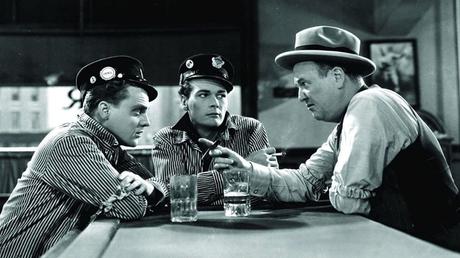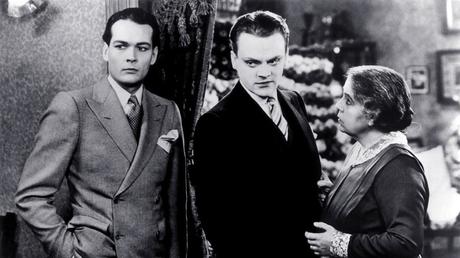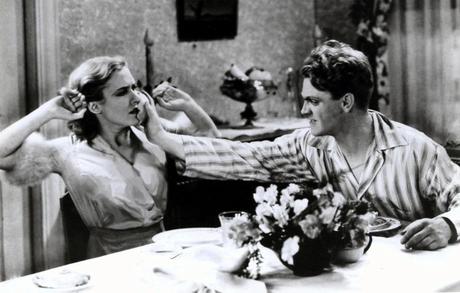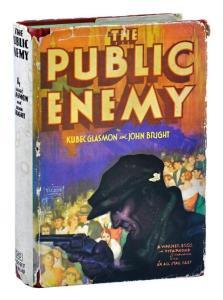
Shortly after Little Caesar made a star out of Edward G. Robinson, James Cagney had his own star-making turn in another gangster classic: The Public Enemy. There’s much to say about The Public Enemy in terms of its place in the gangster genre, James Cagney’s performance as Tom Powers, and its importance to Warner Brothers Studios in general. But what often isn’t discussed is the book it was based on.
Book & Movie Differences
The Public Enemy is a bit unusual in the world of book-to-film adaptations in the sense that most of these adaptations involve books that have been published. The Public Enemy was based on Beer and Blood by John Bright and Kubec Glasmon, but Warner Brothers bought the rights to Beer and Blood before it was published. Eventually, the book was published under the title The Public Enemy, but I’m under the impression that the book that was published wasn’t simply Beer and Blood with a different title. In an interview with John Bright, recorded in 1988, he used the word “bowdlerized” to describe the version of the book that was published. (On a related note, this interview with John Bright is absolutely worth a read. He talks about everything from forming the Screen Writers Guild and being blacklisted to trying to throw Darryl F. Zanuck out of a window.)
While it seems that the version of the book that was published was changed from its original form, it definitely wasn’t a basic novelization that was put out to capitalize on the success of the movie, either. Much of what happens in the movie does happen in the book, sometimes with some small changes involved. For example, during the fur warehouse robbery, Tom isn’t the one who shoots the stuffed bear by mistake in the book. But there’s a whole lot in the book that we don’t see in the movie, or is briefly alluded to in the movie, so it seems safe to assume that the published version of the book likely kept a lot of the original Beer and Blood story.

One of the biggest differences between the book and the movie concerns Tom’s law-abiding brother, Mike. In the movie, he goes off to serve in World War I and returns home shortly after, which makes him a consistent presence throughout the entire movie. In the book, he’s largely out of the picture. Mike needed medical treatment after his service, which he received out of state and he didn’t come home until fairly late in the book.
In both the book and the movie, once Mike is back home, Tom’s lifestyle immediately becomes a point of contention between the brothers, with Mike confronting Tom and telling him that he knows Tom’s money isn’t coming from politics like he had been telling their mother. In the movie, this reads as Tom simply telling his mother a cover story. But in the book, a local politician had gotten involved with Paddy Ryan’s gang and the gang had been involved in helping the politician get elected.
On a final note about Mike, even though he is solidly on the side of law and order in both the book and the movie, he actually does eventually team up with Paddy Ryan. After the rival gang kidnaps Tom from the hospital, Mike goes along with Paddy and Matt Doyle (who lives a bit longer in the book than he does in the movie) to confront the gang and get Tom back. This ends with Mike throwing grenades and blowing the place up.

While Mike is a smaller presence in the book, Gwen Allen has a much bigger part in the book. Jean Harlow wasn’t really given a whole lot to do with the part, but the book made her seem like a more interesting character. A lot of attention is given to her relationship with Tom, which let us learn more details about her, such as the fact that she was divorced. There was also a scene where Tom and Gwen go out to dinner with Nails Nathan and Tom ends up feeling insecure when Nails and Gwen hit it off because they’ve led more sophisticated lifestyles than Tom has. She also does eventually break things off with Tom and when Tom gets the farewell letter she had written to him, he gets very drunk and opens fire on a rival gang, which is what leads to him going to the hospital after getting shot.

The most notorious scene from The Public Enemy is easily the one of Tom shoving the grapefruit in the face of his girlfriend, Kitty. The grapefruit is not in the book, but the grapefruit in the face is surprisingly a kinder send-off than Tom gives her in the book. In the book, there’s a scene where Kitty tells Tom that she’s expecting a baby and he tells her to get lost and refuses to give her any money. Matt was so appalled by Tom’s treatment of Kitty that it put a strain on their lifelong friendship. Later, Kitty’s brother tries to confront Tom about it and Tom nearly beats him to death. Paddy Ryan ends up stepping in to pay for the brother’s hospital bills.
Is the Book Worth Reading?

The good news is that the book is very much worth reading. The bad news is that you have to be pretty lucky to be able to check it out. As far as I can tell, the only time the novel version of The Public Enemy was ever in print was around the time the movie came out, so now it’s very difficult to find a copy of the book that’s sensibly priced.
I really hope this one eventually gets republished because it was my favorite of the six crime-themed books I read for this year’s summer reading series. On a personal level, I’m very glad that I didn’t end up being disappointed by the book I’d spent a few years keeping an eye out for. It’s a really engaging book and it’s pretty clear that Kubec Glasmon and John Bright were quite knowledgeable about the ins and outs of Chicago and its prohibition-era bootlegging scene.
One of the most striking things about the book is how it pulls no punches. You definitely cannot accuse it of glamorizing a life of crime or portraying Tom Powers as a person anyone should ever aspire to be like. The book makes Tom someone who becomes so unlikeable that even Matt Doyle and Paddy Ryan, the two people he was closest to, didn’t like him very much at times. It also doesn’t sugarcoat the fact that these people weren’t just running bootleg alcohol to speakeasies around town, they were murderers.
John Bright had described the novel as being “bowdlerized,” but that leaves me with this question: if this is a cleaned-up, sanitized version of Beer and Blood, what on Earth got left out? On top of some of the things I’ve already mentioned that didn’t make it into the movie, there are times when the book gets into some pretty dark details. For example, during the scene where Paddy, Matt, and Mike try to get Tom back, Paddy shoots one person in the head and others are tortured with hot irons and pliers. The movie is tough, but the book is even tougher.
This review is part of the 2023 Classic Film Summer Reading Challenge hosted by Out of the Past. For more reviews on books related to classic film, be sure to follow the #ClassicFilmReading hashtag on social media.
